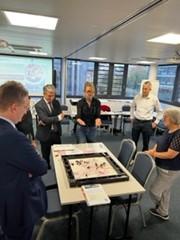The transition from linear to circular economies requires fundamental rethinking of trade policies and regulations. “Harmonized System” codes (HS codes) are a key pillar of the tariff infrastructure for international trade. These HS codes were designed at a time when circular economy considerations were not prominent in economic policy debates. Due to this, the HS Code system is currently considered limited for circular goods and requires innovation and improvement. At the WTO TESSD event held on 11 November 2022, key actors and organizations gathered to discuss efforts being made in the realm of trade and sustainability. At this event, discussions highlighted the need to focus on HS codes in transitioning to circular economy. This emphasis on HS codes was a focus of a recent UNECE FES joint event.
Aiming to address trade-related challenges and to support circular transition, UNECE and FES joined hands to host an event “Deep Dive into Circular Economy: HS Codes at Heart.” This three-day event brought together a variety of experts, country delegates, and professionals to discuss the circular economy and the importance of HS codes in achieving circularity.
The event opened with a high-level debate, open to the general public. High-level representatives from the missions of Austria, Germany, and Kazakhstan spoke on the importance of committing to circular economy principles, and the concrete steps that are being taken within their own countries to implement sustainability.
In his opening remarks, Hajo Lanz, Director of FES Geneva and the co-host of the event, stated that the circular economy is a topic that “finds itself on the priority list of the international agenda, it is so well discussed, rationalized, intuitively clear and simple and the same time has become – as the EU Commission called it 2019 – an ‘irreversible, global mega trend’.”
The discussion then shifted to Mr. William Neale speaking as a representative of the European Commission, and Mr. Josip Pervan representing the World Business Council for Sustainable Development. The two experts went beyond surface-level approaches to circular economy, delving into the specific ways that countries can increase their sustainability while remaining efficient. Attention was given to circularity hot spot sectors, such as textiles, minerals (including critical minerals), and agri-food, as well as possible ways forward for aligning trade, investment, and innovation with circularity efforts. In sum, the high-level opening highlighted the need to approach circular transitions in inclusive manners.
As discussions evolved, Ms. Andrea Hvistendahl, an art professor from Sweden, created a painted piece of artwork featuring various items of trash. Transforming the debate into a piece of art, Ms. Hvistendahl demonstrated that already-existing materials can be used to create artwork, rather than starting from scratch. The art piece represented circular concepts of sustainability, waste prevention, plastic pollution, and the need to reuse and recycle.
Over the next two days of intensive working meetings, 20-plus representatives from the different facets of the circular economy came together to share their unique perspectives. These representatives included members of both the private and public sectors, from a variety of different agencies, based in Geneva and throughout Europe.
The HS code discussion centered on ways to integrate more circular economy approaches into HS code creation. Experts brainstormed concrete takeaways to implement from sessions, which included the need to address the shortcoming of HS codes and classifications. Takeaways also centered on education and flexible approaches as key tools in increasing trust, transparency, and communication.
The largest powerful takeaway centered on the fact that HS codes need to be understood by a wider audience because they play an important role in the transition from linear to circular economy. Ensuring that decision-makers and experts understand both the strengths and limitations of HS codes will help streamline this transition to circularity. Various technical measures are needed to complement the transition process. HS codes cannot solve every problem in the transition to greater sustainability and circularity, though they do play an integral role.
Led by art professor Andrea Hvistendahl, participants took part in creative interactive brainstorming activities to debate ways to build bridges and remove obstacles that hinder the adoption of circular economic principles. Experts identified the key global actors in the circular economy and brainstormed shared interests and ways to make compromises to streamline progress.
More information can be found here: UNECE&FES workshop Deep Dive into Circular Economy: HS Code System at Heart | UNECE


